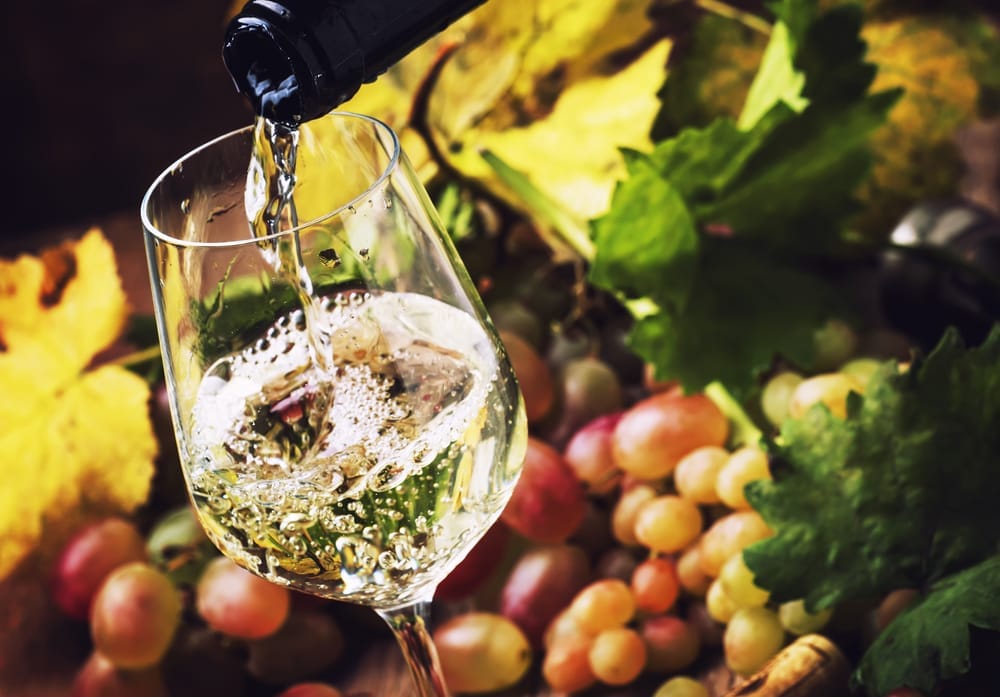Sweet wines are deliciously refreshing drinks that have been on the rise in terms of popularity over the last few years.
If you want to see what all the fuss is about, there is one question you may be asking yourself: which sweet wine do I choose?
When it comes to sweet wines, two varieties rise above the rest: Moscato and Riesling. These widely popular sweet wines are the best of the best. But which do you buy?
That’s where we come in! Today, we’ll be taking a look at everything you need to know when it comes to Moscato and Riesling – as well as which one wins our sweet wine showdown.
We’ll be taking a look at:
- Moscato and Riesling wine profiles
- Comparing Moscato and Riesling
- Occasions and Preferences for both wines
- Choosing Between Moscato and Riesling
- Wine Serving and Storage Tips.
Let’s go ahead and jump right into it!

Moscato Wine Profile
The history of Moscato is a complex one that begins thousands of years ago in ancient Egypt, where it is believed to have originated.
From here, the beloved wine spread to Greece and Rome – and eventually, to the rest of the world!
The name ‘Moscato’ stems from the Italian word ‘mosca’, which means ‘fly’. The wine was given this name due to the way that bees and other insects are attracted to the grapes used to make it.
Tasting Notes and Varietals
Moscato is an extremely aromatic wine with strong fragrant notes of ripe fruits and honeysuckle.
In terms of flavor, this wine is known for its sweet and refreshing taste. You will notice flavors of tropical fruits, as well as a tang of zesty citrus.
This wine is also light-bodied and lower in alcohol content compared to most other wines, meaning it is easy to drink.
The well-balanced flavor profile and delightfully sweet aromas make Moscato a popular choice for gatherings or to accompany dinner!
Riesling Wine Profile
Though its history is highly debated, Riesling is thought to have originated in Germany.
Its name is derived from the word ‘rüssling’, which means ‘to flow like a stream’. Riesling gradually gained popularity in Europe, before rapidly spreading to all corners of the world.
These days, Riesling is a crowd-favorite sweet wine and is produced in many different regions, resulting in unique and slightly differing flavors and aromas.
Flavor Characteristics and Styles
Riesling has a particularly distinct flavor profile due to its high acidity levels. This makes the wine especially refreshing and sharp.
This wine also has a strong sweetness to it that cuts through the acidity, leaving you with a well-balanced wine.
Depending on the style of Riesling, the taste of this wine can vary from dry to super sweet.
Dry Rieslings often have strong notes of crisp green apple and lemon. Mid-range Rieslings that are both dry and sweet tend to have flavors of ripe fruit and honey. Finally, sweeter Rieslings often have more notes of tropical fruit.
Comparing Moscato and Riesling

There are many differences between Moscato and Riesling – some subtle, some significant. Let’s go ahead and take a look at some of the ways that these two popular sweet wines can differ:
Sweetness
Moscato is often the top choice for wine lovers with a sweet tooth!
This wine has a delightful fruity sweetness to it, more so than that of a Riesling. That being said, many styles of Riesling can have a strong sweet flavor to them.
At the end of the day, it depends on the particular type of wine you choose.
When selecting a Moscato, you are almost always going to pick up a sweet wine! When grabbing a Riesling, there is a chance that you will select a dry variation that is less sweet than other styles.
For this reason, those looking for a sweet wine are more likely to gravitate towards a Moscato.
However, if you are well-versed in the different styles of Riesling and can identify a sweet variety, then you will be able to satisfy your sweet tooth with this wine.
Acidity
If you want a wine with higher acidity levels, then Riesling is definitely the way to go.
This wine is known for its sharp acidity, which leaves you with a refreshing drink. There is certainly some acidity to be found in a Moscato, but this wine really shines when it comes to sweetness, not acidity.
Aroma
Moscato often has a very identifiable aroma of fruit with floral notes. This wine is very aromatic due to the intense scent of ripe fruit and honey that it often gives off!
Riesling, on the other hand, has a much broader range of aromantics. Depending on the variety you are drinking, you may notice aromas of citrus, stone fruit, and floral notes.
Production
Moscato is most commonly produced in Italy as well as a few other regions that produce the Muscat grapes which are used in its creation.
It is in the Piedmont region of Italy that Moscato d’Asti and Asti Spumante wines are crafted.
When it comes to the production of Riesling, you will see this wine being crafted all over the world.
Each region that produces this wine will have slight variations in taste and aroma, making Riesling a wine that has a broader range than Moscato.
Also Read: Is Riesling Sparkling or Still Wine?
Aging Potential
Moscato is generally intended to be enjoyed during its youth, meaning that it doesn’t have great aging potential.
If you are on the hunt for a wine that is going to age particularly well, Moscato likely isn’t going to be the best choice for you.
Riesling, on the other hand, has excellent aging potential. The high acidity that is present in this wide means that it ages wonderfully and it is known to develop more complex flavors over time.
Food Pairings
Moscato has a strong sweetness to it which means it pairs wonderfully with a few dishes.
Fresh fruit and desserts are always a great choice, as they will enhance the notes of fruit and sweetness that are present in Moscato.
Riesling possesses a dry acidity that compliments savory foods extremely well. Meals such as seafood dishes, spicy Mexican and Asian cuisines, and poultry will pair wonderfully with Riesling.
Occasions and Preferences
One of the best times to crack open a bottle of Moscato is after dinner!
The sweetness and fruity notes that are in this wine mean that this drink can act as a form of dessert. It also pairs well with many common desserts, such as chocolate and fruit.
Riesling has a broad variety of styles and flavors, meaning that it works well for a huge range of occasions. Whether you want to enjoy a drink alongside your dinner or are simply craving a refreshing glass of wine, Riesling is a great pick.
Choosing Between Moscato and Riesling
Whether you opt for a Moscato or a Riesling is entirely dependent on your personal preferences.
If you want a sweeter wine that pairs well with fruit and desserts, then Moscato is likely the best choice for you.
If you’re on the hunt for a drier, refreshing wine with a pleasant acidity, then Riesling is sure to have what you are looking for. Riesling also has a broad range of styles that can suit all sorts of tastes and preferences!
Wine Serving and Storage Tips
When serving Moscato, you won’t need to follow any strict rules regarding temperature.
This wine is very flexible when it comes to serving temperature and can be drunk ice cold or warmer depending on your preference.
As mentioned, Moscato is best served in its youth, so it is not encouraged that you store this wine for a long period of time.
If you do want to store this wine, keep it in a temperature-controlled wine fridge.
The acidic and refreshing nature of Riesling means that this wine is best served cold – but not too cold, as this can negatively impact the flavors and aromas! A temperature of around 45-50 degrees Fahrenheit is ideal for a Riesling.
Again, storing any open bottles of Riesling in a wine fridge is your best bet if you want to preserve the flavor. If unopened, Riesling can be stored in a cool, dark place such as a wine cellar.
Final Words
At the end of the day, both Moscato and Riesling have excellent qualities and flavors.
The sweet and fruity taste of a Moscato is a great choice for after dinner, whereas the varied acidic flavor of Riesling pairs well with many spicy and savory foods.
If you are unsure which wine best suits your tastes, the best thing that you can do is explore the flavors of both!
Whether you choose a Moscato or a Riesling, there is no doubt that you will be impressed with the unique aromas and flavor profiles of these popular sweet wines.
Also Read:
Moscato vs. Chardonnay: 10 Key Differences
Riesling and Moscato Face-Off: Comparing Sweet Wines
- Moscato vs Roscato: A Comprehensive Comparison of Sweet Wines - December 15, 2023
- Should White Wine Be Chilled? Expert Insights on Serving Temperature - December 14, 2023
- Moscato vs Riesling: A Sweet Wine Showdown - December 8, 2023










